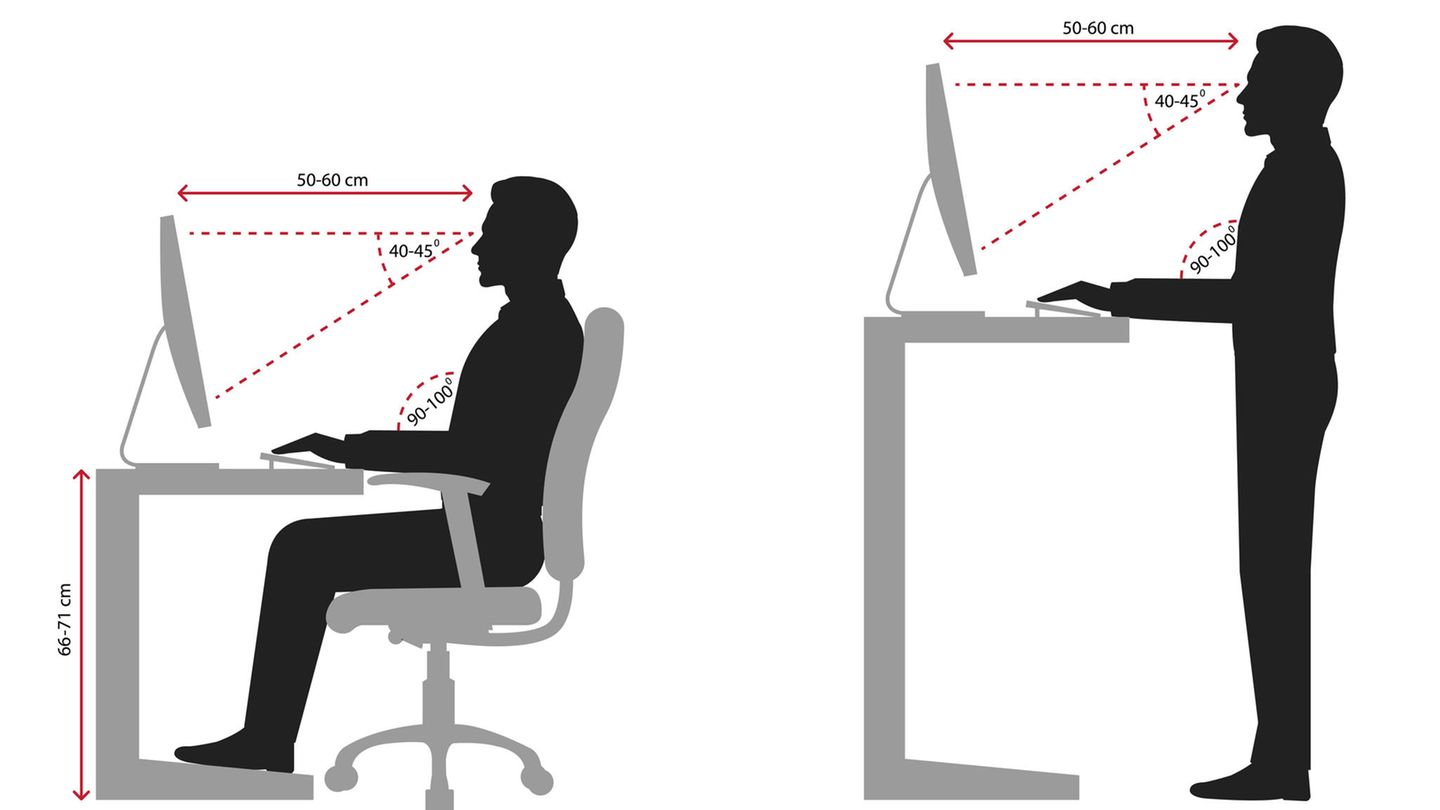Working while sitting or standing
Ergonomics at the workplace: How to prevent physical symptoms
Copy the current link
Add to the memorial list
Although our body is not suitable for long sitting, we spend hours at the desk. So that no complaints creep in, the workplace should be ergonomically aligned.
According to a current muscle skeleton system, such as back pain is still at the top of all types of illness: Here, the health insurance company recorded a plus for the previous year. The often work -related suffering is funded by a lack of or even missing ergonomics in the workplace. This applies in particular in administrative professions – around 35 percent of the lawsuit about cross pain, more than 50 percent about problems with the neck. And these are by no means all complaints that are encouraged by false sitting at the desk. In addition to the already mentioned, the most common symptoms include: problems with the shoulder or wrist as well as headache and tension pain. The question arises as to how the workplace should look ergonomically correct so that you can prevent (further) work -related diseases?
The desk
Many employees are satisfied with their desk, even if he does not meet all the criteria that are necessary for a healthy workplace. What most people do not know: There are special guidelines for ergonomics at work that every employer – purely legally speaking – must comply with. This includes, among other things, and that is to be largely minimized by preventive occupational safety, working -related burdens in order to increase well -being, motivation and the performance of the employees in the long term.
Since it is proven to have only two thirds of the working day while sitting and a third of it standing up, are or The best choice. They allow the employee to work both while sitting and while standing – according to their own taste. This not only relieves the spine, but also the intervertebral discs. And these are both important factors for a healthy back. Ideally, the desk is set so that it is between 66 and 71 centimeters high from the floor, this is at least the optimal working height.
Furthermore, the desk should be at least 80 centimeters deep and 160 centimeters wide. However, the height and size of the area are not the only criteria for an ergonomic workplace: the distance between the seat and table is also important – it should not be more than 18 to 30 centimeters. They are right when their forearms lie horizontally on their desk and have enough legroom under the plate, so that they may also be one can accommodate. This is used especially if the desk is not adjustable in height or is still too high even at the lowest level.
Another tip: If you already suffer from back problems, you will receive a recipe for the height -adjustable desk from your family doctor, which you just have to submit to your employer.
The office chair
At least as important for ergonomics at work is the . Even if he is not cheap to buy, it still costs the employer less than a single day of illness. So that you can optimally adjust it to your needs, it must meet the following criteria: it should be adjustable in height and have a flexible or tiltable backrest that can adapt to your weight. Ideally, the armrests are also adjustable in height and the seat in the depth. An additional inclination option for the seat is also recommended.
When the chair fulfills all of these factors, set it up in such a way that your upper and lower legs as well as their upper and forearms form a right angle. The height must be set so that your soles of your feet touch the complete floor and place your forearms on the desk so that your shoulders are not pressed up. Here can be an additional be of great benefit if you feel that you cannot implement the above -mentioned settings in the form. To make sure you have done everything right, it is best to get a colleague who controls your attitude.
The monitor
According to the CDURITY MARKING OFFER, the employer is obliged to assess the risk. In plain language, this means: In every company, it must be ensured at all compartments that its employees – with regard to their safety and health protection – are not at risk. In any case, the requirements for the eyes as well as possible physical and psychological stress must be included in the assessment. You can read about which guidelines must be observed in detail.
When buying a new one If you are sure to make sure that it is flicker-free, has good contrast values, is at least 22 inches in size and has a high-resolution LCD display. Then set up the screen parallel to the keyboard and your own shoulder axis. In addition, the upper part should be slightly tilted backwards – the upper edge of the monitor, on the other hand, has to be a bit below the eye level. Because the fact is: working on the screen is more relaxed for the eyes if the visual axis is slightly inclined down.
The light
The light also plays a crucial role in ergonomics at work: the ideal lighting consists of a mixture of direct and indirect light, daylight and artificial light (e.g. one ) – In the best case, the artificial light sources are also individually adjustable. As for the desk, the light should fall on the side and not be brighter than the natural daylight. For this reason, the workplace must also be set up in parallel to the window. This is the only way to make ideal lighting conditions.
The advantages
An ergonomic workplace may be associated with high costs, but it should be clear to every employer (and also employee) that many advantages are associated with this:
- Each ergonomic measure is a preventive action. Say: If the workplace is set in such a way that typical professional diseases are prevented, the releases of the employees decrease. In addition, the risk of accidents is also minimized. In both cases, they save costs.
- Many employees already suffer from chronic back or neck pain. Here, too, an ergonomic workplace can ensure that the symptoms are relieved and the well -being at the desk is increased. And that in turn ensures that they reduce further suffering.
- Especially if previous illnesses of employees are already known, it is imperative to make the workplace ergonomically. On the one hand, they convey a feeling of appreciation to their employees, and on the other hand they increase the productivity of their employees.
- When employees feel taken seriously, the chances are very good to bind them to a company for a long time. Especially when the jobs are designed in such a way that they are ergonomically correct even with age. Due to the positive association with your office, your employees feel comfortable for many years.
*This article contains so-called affiliate links to products in online shops. If a user clicks on it and buys something, the publisher receives a commission from the dealer, not from the manufacturer. Of course, where and when you buy a product is up to you.
Source: Stern
I’m Caroline, a journalist and author for 24 Hours Worlds. I specialize in health-related news and stories, bringing real-world impact to readers across the globe. With my experience in journalism and writing in both print and online formats, I strive to provide reliable information that resonates with audiences from all walks of life.




